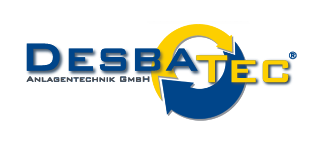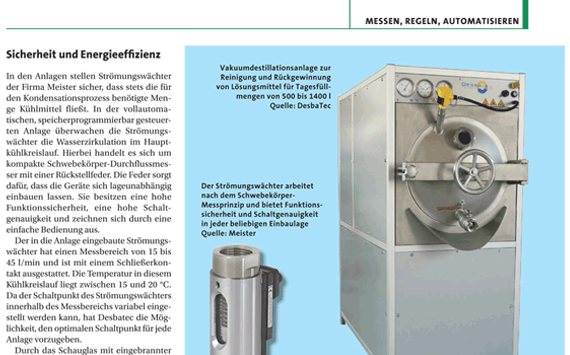When measuring pressure is not sufficient: flow controllers monitor coolant circuits at vacuum distillation of solvents
- Published: Wednesday, 22 October 2008 12:37
In the production of printing plates a large amount of solvents is used for washing out the photopolymer plates. At a certain level of contaminsation, the solvent must be cleaned by vacuum distillation for quality reasons. To ensure the safety of the condensation process, it is not sufficient to measure only the pressure. It is feasible to use flow controllers to monitor the coolant flow directly.
In the process industry it is often not sufficient to visually monitor flow rates. Therefore, for electrical monitoring of the minimum and maximum flow rates, for controllers are used which are equipped with switching contacts for monitoring the limit values. These switching contacts are triggered, if the set limits are exceeded or undercut. A power supply is not required since these are potential-free Reed contracts.
In the printing industry the printing plates have to be cleaned at the end of the production process. A large amount of solvents are used for this. The cleaning takes place in special washing facilities with suitable solvents. During the washing process, the solvent is contaminated, for example with photopolymers. As soon as the solvent in the washing facility reaches a pre-defined level of contamination it has to be replaced. This can be done either by disposal or cleaning. In order to reduce costs and protect the environment, the cleaning gets more and more important. Many companies today are choosing to optimize their production and to clean the contaminated solvents on site. In addition to a significant reduction of disposal costs, the purchasing of fresh goods (solvent) and the storage cots can be reduced and at the same time supply shortages are avoided. Furthermore the companies remain independent of paid recycling and there is a ever-constant high distillate quality available.
The company DesbaTec Anlagentechnik GmbH in Sulzbach, provider in the area of recycling- and environmental technologies, has specially developed vacuum distillation units for this use case, which can be integrated optimal in existing production- and cleaning systems. DesbaTec is able to react quickly and flexible to customer demands and can minimize or avoid completely production disruptions or interruptions during the set up of the units.
Separation by distillation
In the plants contaminated solvents are heated by the use of heat transfer media, such as oil, hot water or steam, and brought to boil. Since thermal composition can happen at sensitive substances during evaporation and in order to simultaneously reduce energy consumption, the gentle separation process of the vacuum distillation is used.
With the vacuum distillation the boiling point of the liquids to be separated is greatly reduced and the substances evaporate at a much lower temperature than under atmoospheric pressure. A vacuum pump sucks the vapors through a condenser. Largely by the lack of confounding factors such as air and inert gas an ideal heat transfer is taking place, through which a very efficient recovery of the solvents is possible. The resulting vapors are reduced into a fluid state and cooled through the cooler unit.
Fotr the condensation process a failure-free function of the coolant circuit is essential. For this reason the operation fo coolant circuit is monitored. But for the monitoring it is not sufficient only to measure the pressure in the coolant circuit since current pressure does not necessarly mean that enough coolant is flowing. In order to assure safety of the process the flow has to be monitored directly.
Safety and energy efficency
Within the plants the flow controllers of the company Meister make sure that always the required amount of coolant for the condensation process is flowing. In the completely automatic, programmable logic controlled unit, the flow controller monitor the water circulation in the main cooling circuit. These are compact float flowmeter with a return spring. The spring ensures that the devices can be installed in any position. They have a high reliability, a high switching accuracy and are charaterized by a simple operation.
The buit-in flow controller has a measurement range from 15 to 45 l/min and is equipped with a make contact. The temperature in this cooling circuit is between 15 and 20°C. Because the switching point of the flow controller can be varied within the measuring range, DesbaTec has the ability to define the optimal switching point for each plant.
The sight glass with burned-in scale allows simultaneous visual monitoring of the cooling circuit. Despite of the glass it provides a high pressure and temperature resistance. In addition to the robustness the independence of the position and the compact design are other advantages of the flow controller.
The measuring principle used is charaterized by short response times and low susceptibility to interference in case of formation of bubbles in the coolant. Due to the accuracy of the device there is no need for safety margins which have to be obeyed in the flow so that the flow controller not only offer a high process safety but also ensure a efficient use of energy.
The dissolved solids normally do not evaporate upon the distillation process, but remain in the distillation vessel. The units operate automatically and are designed for 24-hour operation. Only the discharge can also be done manually. The discharge of residues is done manually, either with liquid residues via a drain cock or with semifluid respectively solid residues via a cleaning hatch and a cleaning tool.
Antoher example for the use of flow controllers is a units, which is equipped with a heat carier heating (thermal oil). In systems of this type, flow controllers are used to additionally monitor the oil flow. For thise use cases the flow controllers are equipped with high temperature switching contacts, which can be used up to a temperature of 160°C. The cleaning of this unit is done automatically by a springloaded scraper system, the discharge is also done automatically by a pneumatic discharge gate. With this type of system, a distillation capacity of 100-140l/h is be reached.
Successful cooperation
Depending on the application the flow controllers from the company Meister was selected as the optimum flow switch. These include, for example, stainless steel appliances, devices in fullmetal body with attached display or devices with explosion-proof contacts with ATEX approval. Thus, the condensation proecess is monitored at all times safe and there is a ever-constant high quality distillate. The distillation takes places up to the desired viscosity. The condensed solvent is collected and can be re-supplied.
Magazin "Verfahrenstechnik" (Process engineering), 10/2008
Download the original article (german)

 DE
DE
 EN
EN
